05. Plump and Pliant: The Preservation of Bacterial Cellulose in Textile Bioart
- Courtney Books
Bioart and preservation are unnatural co-players. Distinguished from the control and malleability of biomimetic art, bioart attempts to harness the quasi-uncontrollable growth of living organisms. Biological organisms, with few exceptions, represent an enemy camp for art conservation. Moreover, bioartists often embrace material degradation as an inherent aspect of an individual or iterative work. Conceptual strength is derived from the uniqueness of a living organism, and showcasing its pathway of creation, life, and inevitable decay becomes a type of performance art.
In contrast, some bioartists seek to defy the laws of ephemerality and deterioration by extending the natural life and postmortem span of their materials. A prime example is Doris Salcedo’s A Flor de piel (2011–12), developed in collaboration with scientists. The biotextile artwork consists of thousands of rose petals sutured together with wax thread and treated with a solution of glycerin, collagen, and turpentine. Desiring that the textile remain flexible, Salcedo’s studio has shared with conservators the recipe and method for processing the rose petals.1 Conservation scientist Narayan Khandekar of the Straus Center for Conservation and Technical Studies, Harvard Art Museums, subjected sample petals to the stress of induced environmental aging in order to make the prediction that each petal, many of which have already been replaced, will eventually require a surrogate (). Salcedo has granted permission to remanufacture petals, yet stresses that the piece should not lose function as textile. Curator Mary Schneider Enriquez explains: “It is the impossibility of securing the presence of the absent body and the skin of petals in a lasting physical state that confounds the viewer, and defines the success of this work” (, 129). The rose petals conceptually embody the absent flesh of a disappeared murder victim; the work is a shroud for mourning, and as soon as it loses this functionality, the concept is also lost.
In a similar vein, textile artist Astrid Lloyd constructed a garment from pomegranate peels for the performance piece Mother (2008, fig. 5.1). Despite continuous treatment with vegetable glycerin, the biotextile quickly showed signs of deterioration (absorbing ambient moisture, developing mold, crumbling, and resulting loss of material) and is now housed in an airtight glass case. Lloyd has expressed that the encasement is an undesired barrier but a nonnegotiable solution in order to salvage the piece as wearable and therefore performance-ready. After future manifestations of the performance series, nature can be unleashed on the pomegranate peels, or in the artist’s words: “Like skin, it should age.”2
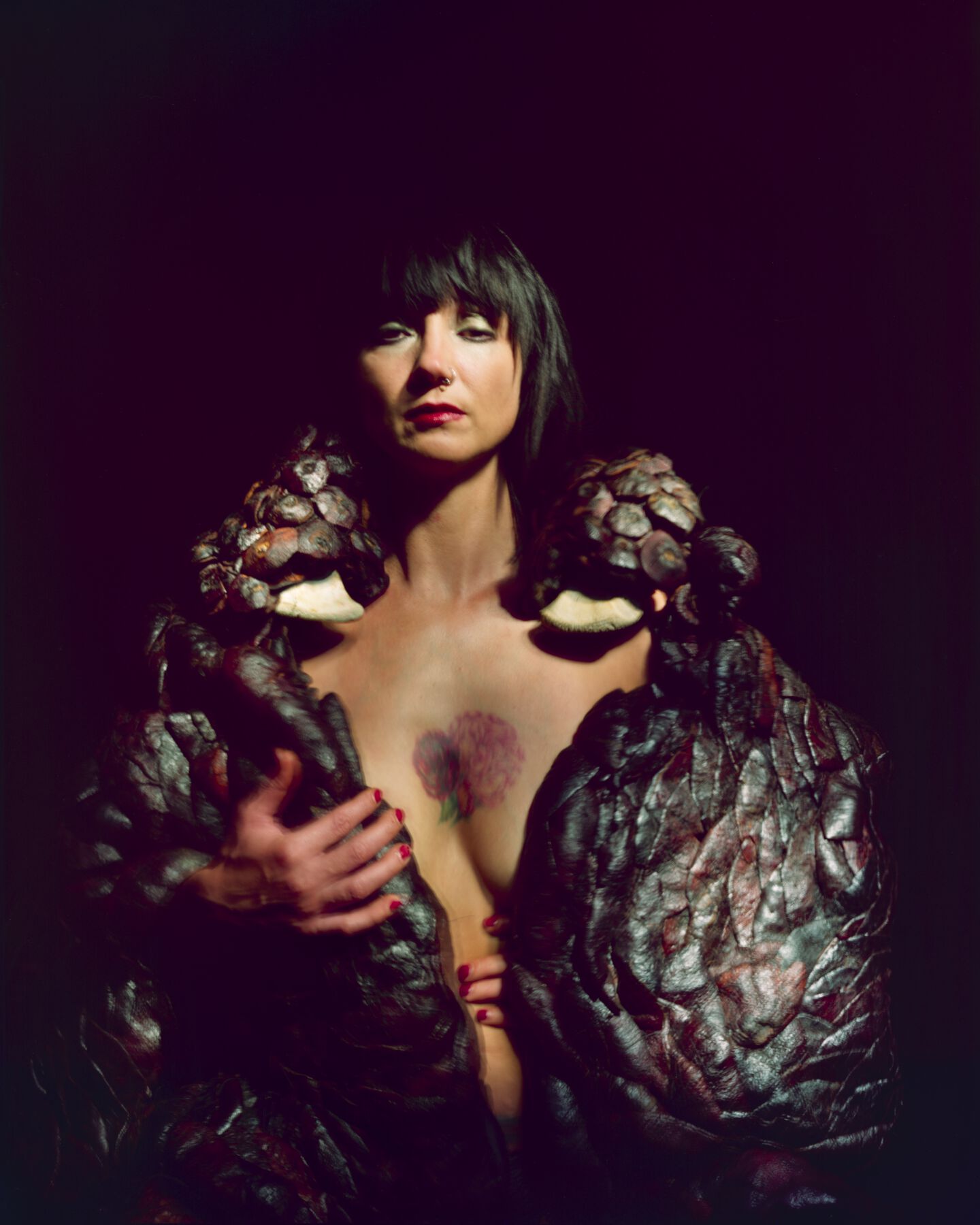
Salcedo and Lloyd represent a clear desire on the part of some artists to extend not only the lifetimes of their ephemeral materials but also degrees of the physical plasticity of biological matter. Biotextiles and the use of cellulosic (plant- or bacteria-derived) biofilms exemplify a subset of bioart where the continued functionality and perception of the material as textile relies upon preservation.
Bacterial Cellulose: A Textile Biofilm with Inherent Vice
In 2017, textile artist WhiteFeather Hunter and biodesigner Théo Chauvirey began experimenting with bacterial cellulose at the Speculative Life Biolab, a research cluster within the Milieux Institute for Arts, Culture and Technology at Concordia University, Montreal. They co-created Bucci (2017, fig. 5.2), a two-piece garment fashioned from bacterial cellulose biofilm and 3D-printed bioplastic.3 While the skirt of the garment was seemingly stable, the shirt, made from thinner biofilm and processed differently (that is, unwashed), was actively falling apart within weeks (fig. 5.3). Why did half of Bucci degrade more rapidly? Would the bottom half succumb to the same fate as the top, and when? Could bacterial cellulose be manipulated to last longer, allowing for a longer exhibition duration?
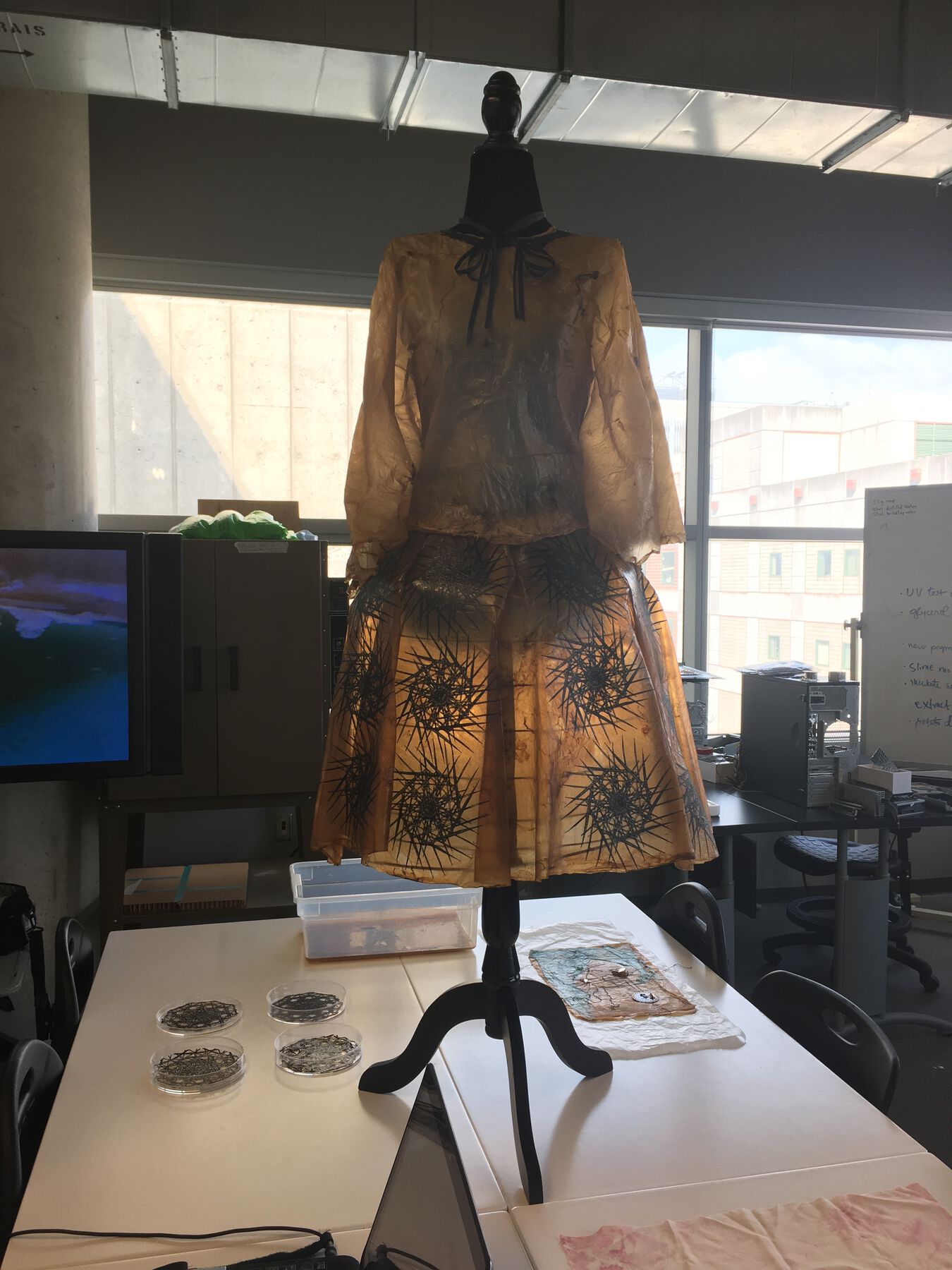
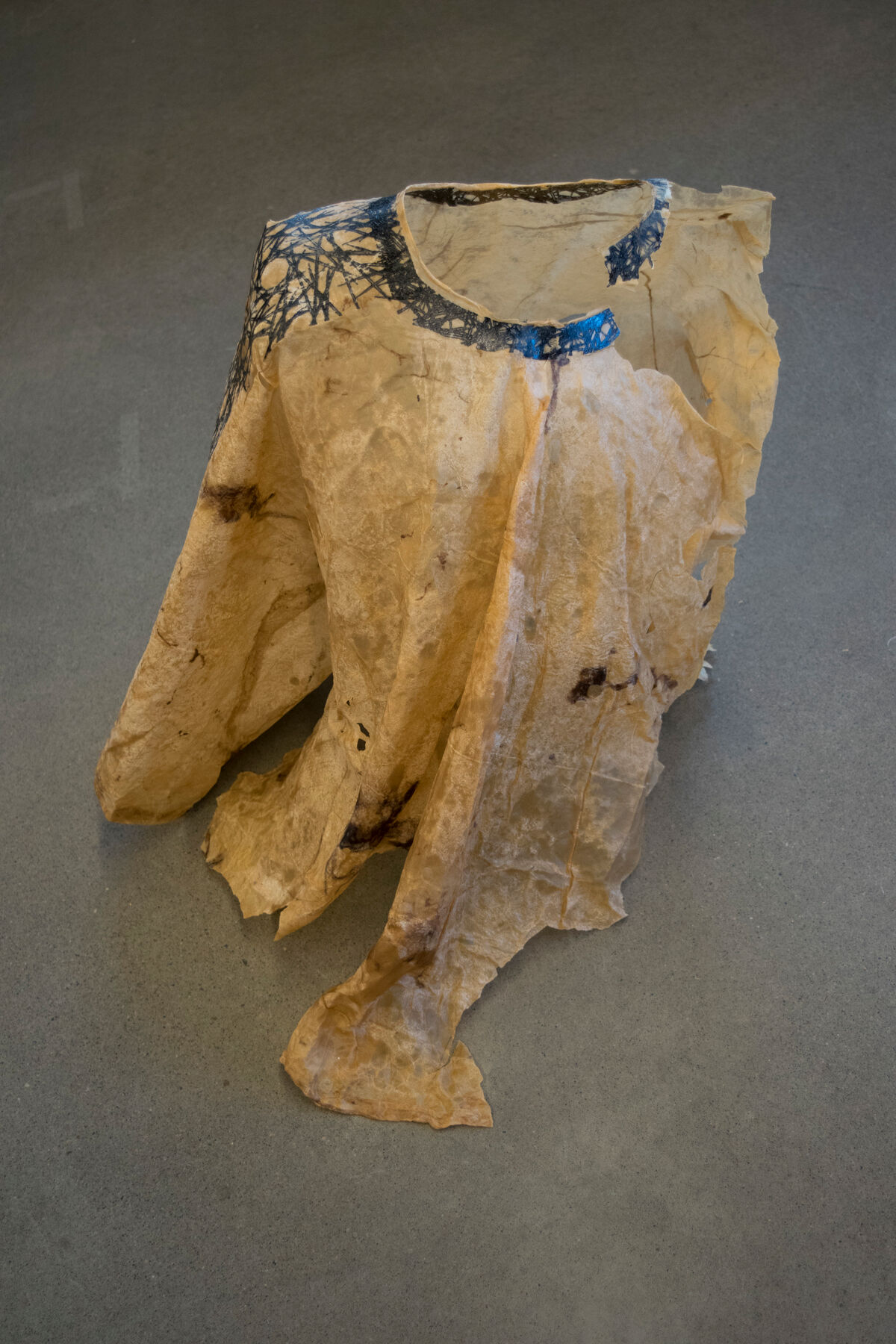
Dehydrated bacterial cellulose, also known as “kombucha leather,” as it is the same substance used to ferment kombucha tea, has surged in popularity as a new textile material due to properties akin to animal and plant-based leathers. Bacterial cellulose is flexible, sustainable, biodegradable, and widely considered ethically responsible. Artists such as Susan Lee, with her TED Talk “Grow Your Own Clothes,” have popularized economical and easily reproducible production methods (). When grown in a large vat, the biofilm colony, scientifically termed a pellicle and commonly referred to as a SCOBY (symbiotic culture of bacteria and yeast), is large enough to produce human-size clothing. Through an aerobic fermentation process that converts simple carbohydrates into acetic acid and carbon dioxide gas, the water-insoluble material grows from an active yeast culture that colonizes in layers to create a cellulosic biofilm. The pellicle conforms to the shape of the incubation vessel as it floats to the top of the air-liquid interface, suspended by the carbon dioxide gas and blocking competitor access to the sugar-laden food source.
Bacterial cellulose differs from plant cellulose in that it contains no hemicellulose or lignin, and is characterized by a higher degree of crystalline structure and polymerization due to the cellulose grouping in microfibril ribbons; this lends the biofilm impressive strength and flexibility (). The hydrated pellicle is firm and fleshlike in texture and sandy-pink hued. Dehydrated pellicles darken to deep sienna-umber hues, lose up to 95 percent of fluid mass, and remain semiflexible. Microscopic photo documentation of cross sections taken from bacterial cellulose illustrates the changes in topographical morphology that occur with natural dehydration; the significant change in texture and hue is evident in images of untreated, hydrated bacterial cellulose (fig. 5.4) versus untreated, dehydrated bacterial cellulose (fig. 5.5). The rate at which the material deteriorates over time varies according to processing, thickness, and environment, but can occur within weeks, as seen in the case of Bucci. Critically, when the dehydrated material is exposed to ambient moisture fluctuation or skin contact, the biofilm’s cellular structure, weakened during dehydration, degrades and the biofilm fractures. This vulnerability results in a short time allowance for static gallery display and an even shorter allowance when worn on a human body. The inherent vice of water vulnerability is still considered the leading obstacle for artists working with this material.
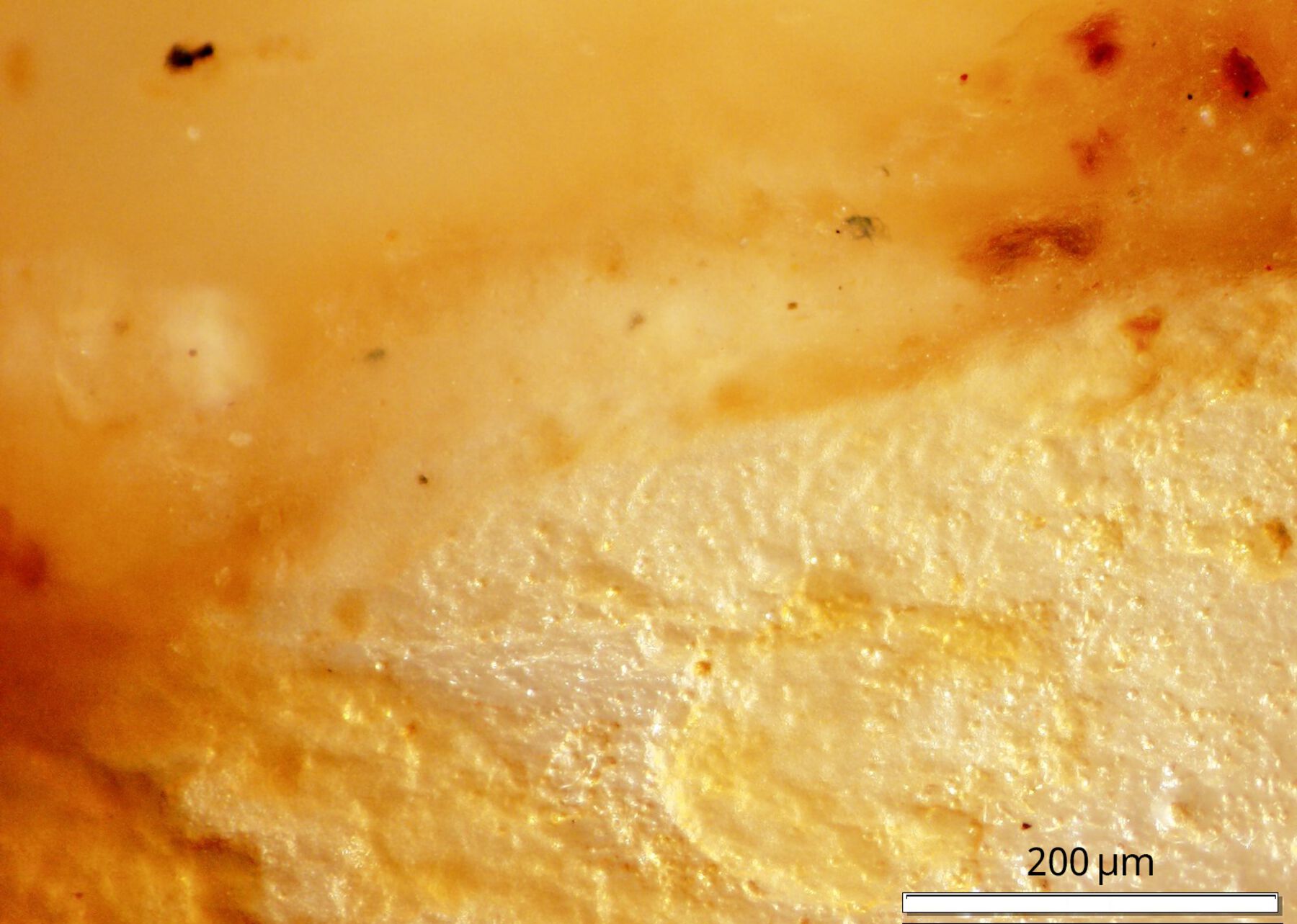
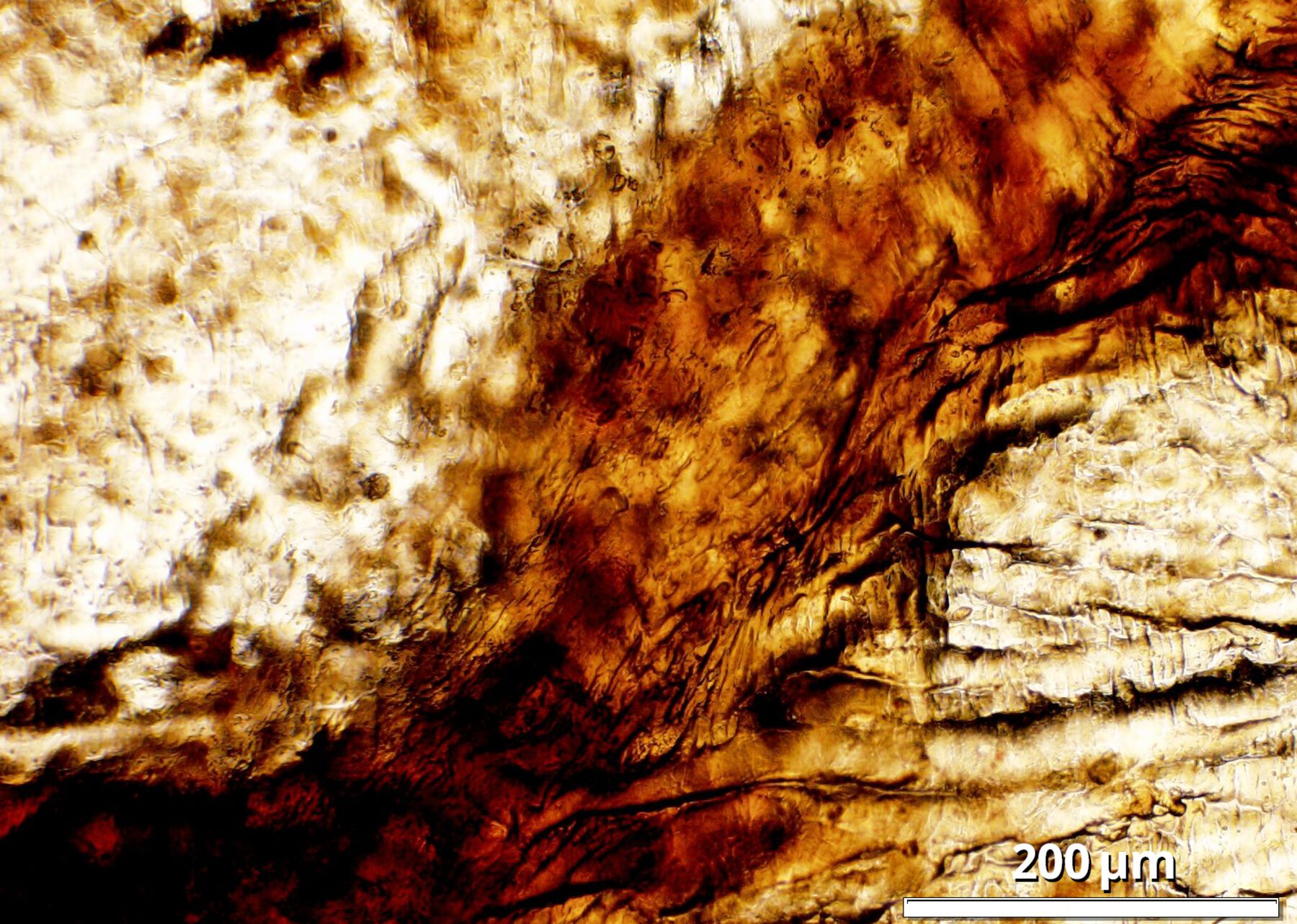
Project Collaboration: Combining Spheres of Art Conservation and Material Production
The degradation that eroded Bucci inspired the collaborative project Plump and Pliant (2017–18), involving the author (art conservation graduate student, Queen’s University, Ontario) and WhiteFeather Hunter (interim principal of the Speculative Life Biolab). The project was driven by a common goal: to create an immersion treatment for bacterial cellulose that would allow the material to persist externally from containment (for instance preservation within a liquid bath, storage and/or exhibition inside a hermetic vitrine, et cetera) while preserving lifelike qualities of pliancy and fluid retention. The challenge was to retain as much fluid, flexibility, hue, and texture of untreated, hydrated bacterial cellulose as possible while reducing hygroscopic properties (that is, imparting water resistance). To note, the primary aim was to extend the viable exhibition time of the bacterial cellulose beyond the threshold of normal degradation processes. Instead of measuring the exhibition window of the biotextile in weeks, artists could exhibit for months and plan for multiple performance-art pieces worn on human skin for longer durations. Significant longevity of the materials (up to one year or more) calls for further research.4
Inspired by Doris Salcedo’s process created for A Flor de piel, Plump and Pliant combined materials and methodologies used in the conservation of waterlogged archaeological organic material with cellular stabilization and dehydration materials and methodologies used in botanical, medical, and food industries (; ). Immersion treatments were selected and adapted from each of these fields based on potential for reducing hygroscopicity in the bacterial cellulose and to minimize cellular-wall damage experienced by the biofilm during and after dehydration.
An overarching parameter of the project was that the resulting immersion treatment method, technology, and materials should be easily reproducible, affordable, nonhazardous, and nontoxic for practicing artists. This stipulation forbade the consideration of cellular fixatives, champion (but also toxic) defenders against decay such as turpentine, formaldehyde, or dimethyl sulfoxide.5 In addition, vacuum-freeze drying, a preferable method of stable dehydration, was omitted due to relative inaccessibility and biolevel safety codes observed by the Speculative Life Biolab (for instance prohibition of removal of biologically active testing material from the laboratory).
Experimentation: Corralling Bacteria into Cooperation
Test samples of bacterial cellulose used for the research project derived from the same pellicle, grown in the Speculative Life Biolab and sourced from RISE Acetobacter xylinum bacteria/yeast. Significantly, this was the same cellulosic body used to create the top piece of Bucci—further verifying the success or failure of the experimental treatments. Ninety-nine samples were cut from the main pellicle (each sized 5 × 5 × 0.5 to 1 cm) and rinsed with distilled water. Half of the samples were sterilized by autoclaving the biofilm at high-pressure steam held at 121°C, while the remaining half of samples were allowed to remain biologically “active” (with bacterial yeast strains thriving or dormant). Each immersion solution was tailored with three main components—a plasticizer, a consolidant, and a preservative—all designed to protect the cellular structure during dehydration and to decrease hygroscopicity.6 Concomitant antifungal properties imparted to the test samples by the immersion treatments were also observed and documented.
The treatment method relied upon cyclic displacement of fluids; alternating between immersion and dehydration stages, the aqueous incubation fluids (mainly acetic acid, leftover sugars, and bacterial strands) were driven out of the samples via capillary forces and replaced with preservative materials (listed below). Dehydration was performed by air drying or with artificial-aging ovens. Samples were often treated first with solvents (for instance acetone or mineral spirits) followed by the immersion baths. To encourage higher penetration and saturation of treatment materials, immersion solutions were gently heated or kept for longer dwell times at room temperature (fig. 5.6). Immersion materials included collagens, glycerol, alcohols, cellulose ethers, and low-molecular polyethylene glycol (PEG: the long-standing darling for consolidation treatment of wood and leather conservation) as well as common preservatives used for fruits and vegetables such as sucrose, mannitol, and waxes.
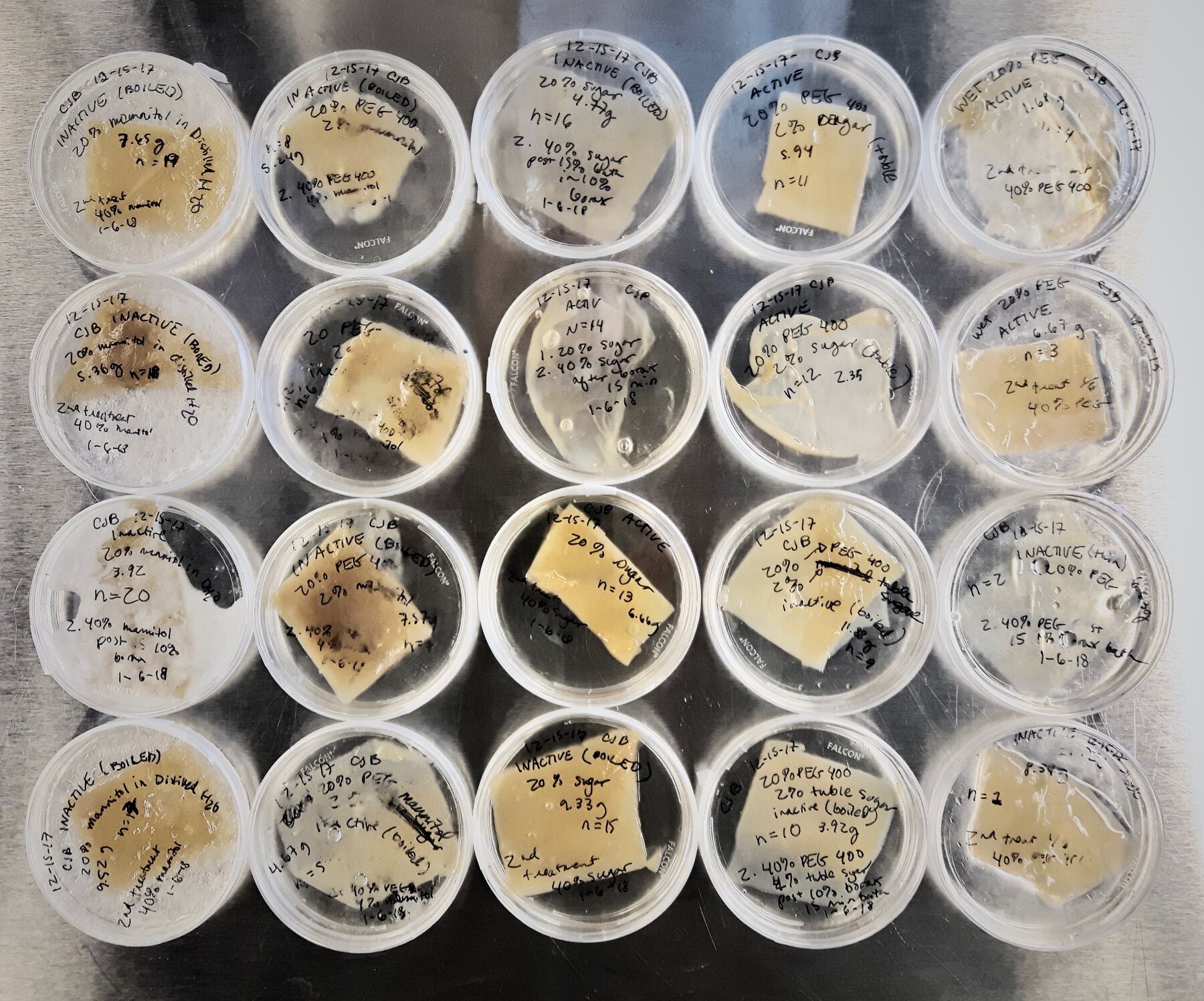
Technical analyses used to map the pilot results included ASTM cantilever bend tests to evaluate preserved or improved textile pliancy, mass/weight calculations to indicate fluid retention, cross sections and polarized light microscopy (PLM), and ultraviolet microscopy (UVM) to monitor adjustments in surface morphology and cross-contamination.7
Results: A New, Biolatex-like Textile Material
Three qualifiers were used to evaluate success: retention of fluid, flexibility, and “lifelike” texture; reduction of hygroscopic properties; and anti-biodeteriogen properties (that is, treated samples that avoided becoming hosts for raging bacterial parties). Of the twenty-one different immersion treatments ultimately tested, three were deemed successful enough to repeat using new samples (deriving from the same pellicle and also from a different pellicle) in order to confirm results. It is noteworthy that several discarded treatments, although deemed losers by the parameters of the project goals, produced materials that were of interest to the consulted artists. For example, despite substantial fluid loss, collagen/glycerol treatments produced a strength and flexibility similar to wearable latex, while treatments with alcohol and PEG produced a semi-firm, gelled texture that was, despite increased tackiness, most suggestive of the lifelike “plumpness” of the original wet biofilm. The dynamic nature of working in a biolab full of practicing artists allowed for a proverbial recipe exchange—some artists recorded discarded treatments (for instance the rubbery, cellulose-nitrate-like results of samples treated with pure collagen) for future art applications.
All treatments aesthetically altered the cellulose to some degree—challenging the goal of retaining lifelike verisimilitude. According to Hunter and Chauvirey (whose voices here are operative as artists), some changes, including in color and in texture, were deemed acceptable as long as the material’s resistance to degradation was strengthened and it “read” as biomaterial: flexible, pliant, and, ideally, plump (indicative of hydration). After the second-phase testing of the three initially successful candidate treatments, one emerged victorious.
Ultimately, a trifecta involving collagen, glycerol, and a polyethylene glycol manifested the most promising results. Despite fluid loss (approximately 60 percent), the aesthetics of hue and surface morphology in these samples were the most unaltered in comparison with untreated, hydrated bacterial cellulose, as visible in the photomicrograph shown in fig. 5.7 (compare with fig. 5.4). This new form of treated bacterial cellulose exhibited a notable increase in flexibility and tensile strength (fig. 5.8) and proved to be water resistant (but not water impermeable). Since untreated cellulose has shown to deteriorate within hours of skin contact, samples prepared with the winning treatment were worn directly on skin for twenty-four hours in order to demonstrate that the treated material could withstand longer exposure to the microenvironment of human skin (moisture, salts, et cetera). At the time of this article submission (approximately three years later), these samples have shown no visible or tactile signs of degradation.8 The new treated bacterial cellulose has achieved a tentative permanence that, while subject to eventual decay, allows for further use in performances and exhibition.
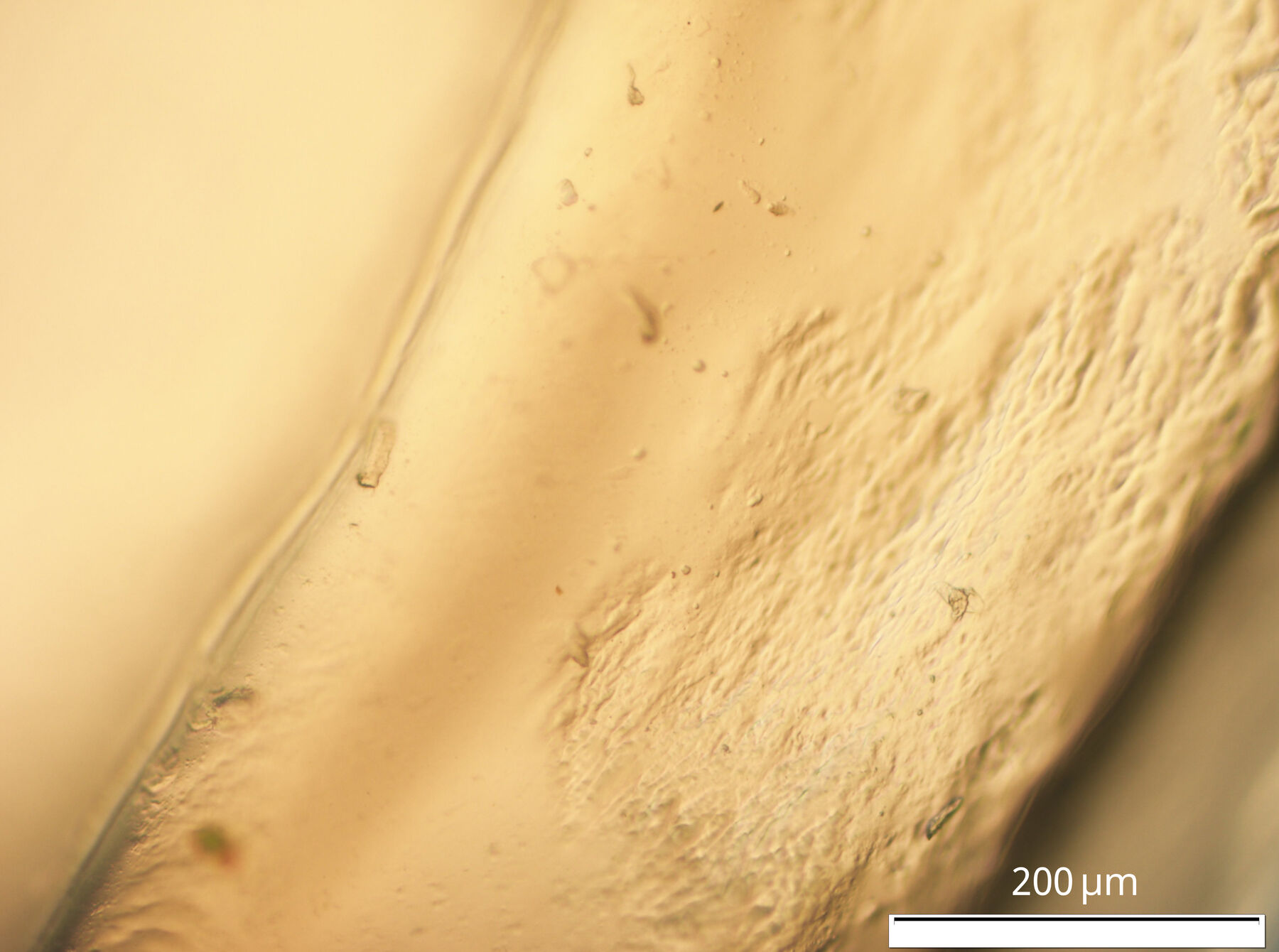
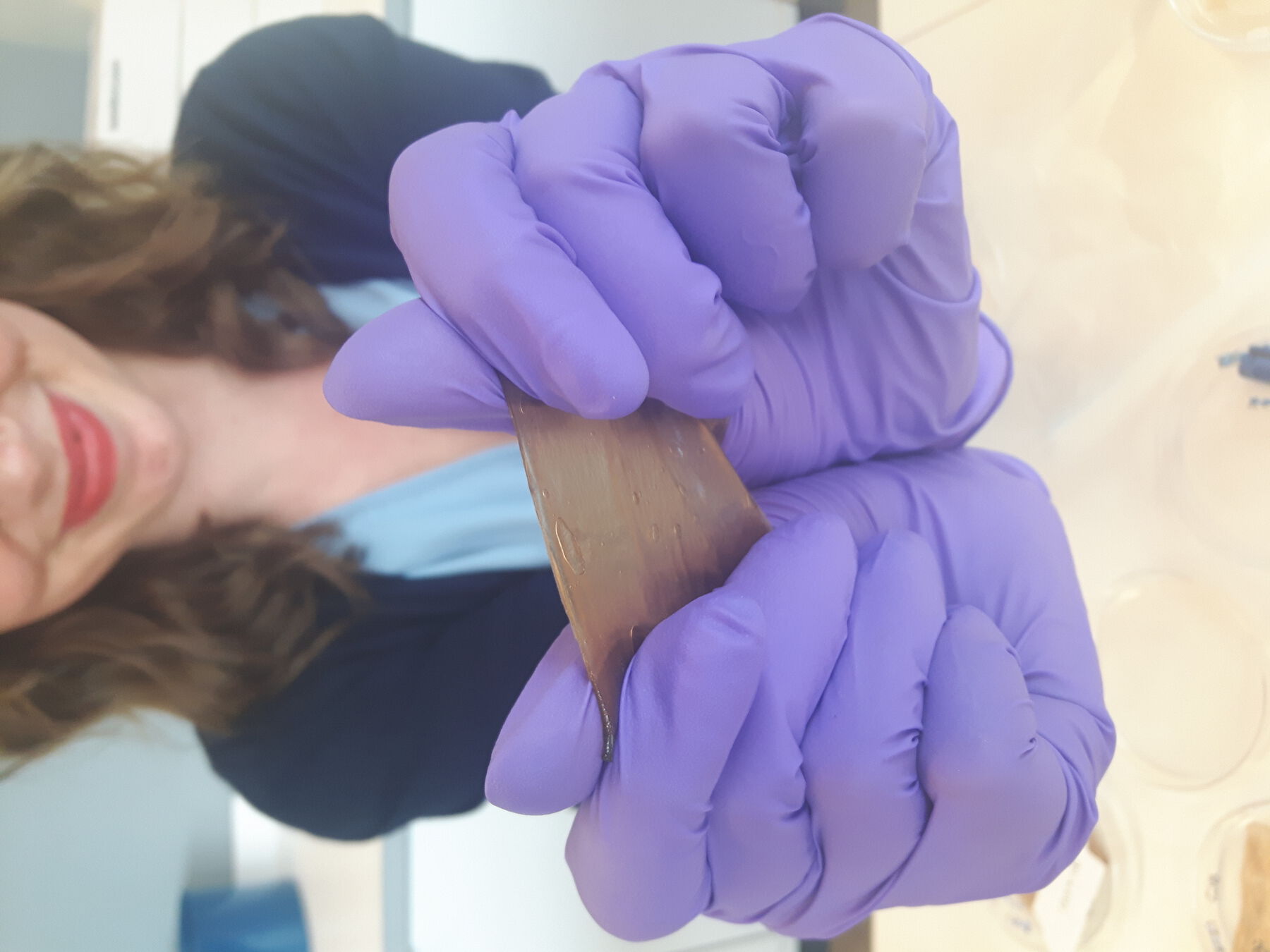
Evolution: Continued Application and Development
The intersections between biofilms and art conservation continue to multiply as new applications for cellulosic biofilms and bio-produced gels continue to pepper conservation literature. Cleaning techniques for treating paper, paintings, and objects that involve rigid, polysaccharide-based biofilms (for instance agar, low-acyl gellan gum) rely upon the capillary action of the still-hydrated gel to perform as a poultice.9 Archaeological conservators have recently attempted to consolidate waterlogged wood by growing the bacterial cellulose internally within the object (). Conservation scientists have explored dehydrated bacterial cellulose as an alternative lining material to Japanese paper (Santos et al. 2016a; Santos et al. 2016b). The potential of treated bacterial cellulose for serving as strength-reinforcing repair material for hygroscopic leathers, parchments, and textiles holds exciting promise.
Perhaps the most compelling results branching from the Plump and Pliant study rest not with what has been created but with what is yet to come. Montreal-based medical scientists, working in collaboration with Hunter, have proposed researching the treated bacterial cellulose as a potential patch material applied to internal tissue repair of mammalian organs.10 Hunter and Chauvirey have received requests to apply the treatment in commissioned garments for an annual festival in Ottawa affectionately named Boochfest.
Moreover, Hunter developed adaptations of the treatment in order to tailor specific properties better suited for a collaboration with bioartist Tagny Duff. This collaboration occurred for the occasion of the 2019 exhibition MATTER(S) Matter(s): Bridging Research in the Arts and Sciences at the Eli and Edythe Broad Art Museum at Michigan State University, Lansing. The work, Wastelands, is an ongoing project created by Duff to include multiple iterations and collaborations ().11 In this iteration, Hunter augmented the recipe proportions of the treated bacterial cellulose to enhance properties of elasticity. She constructed cordage and hand-stitched carriers (fig. 5.9, fig. 5.10) to house Duff’s biogas generators—tiny glass vessels that house excrement, viruses, and methane. In this case, the conceptual performance of the treated bacterial cellulose is implicated in the viewer’s perceived network of anxiety surrounding containment and exposure to bacteria—in the project, the success of the rendered biomaterial transforms it into an effective container of another biomatter—all the while able to be worn, as designed, on an incubator (a living body).
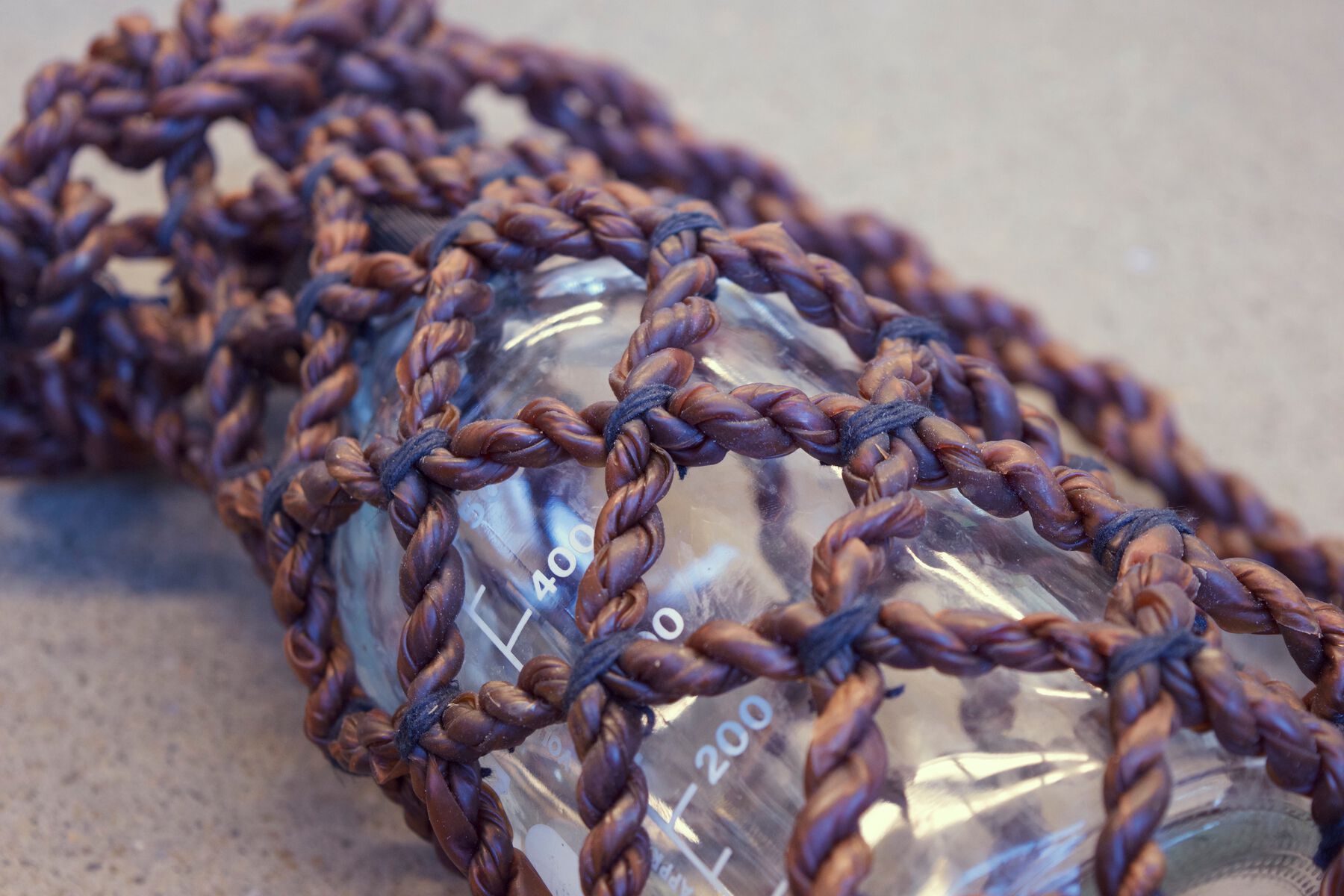

Conclusion: Collaboration between Artist, Conservator . . . and Bacteria?
Initially, Plump and Pliant was designed as a graduate thesis research project in collaboration with an interested and generous bioartist and hosting lab. The project quickly morphed into something more, shifting beyond the core goal to preserve bacterial cellulose in its original, familiar form to the new applications and possibilities of an invented material. As the author attempted to limit variables and establish controls for the project’s parameters, Hunter emphatically pushed in the direction of the experimental in pursuit of results that were actually desirable and applicable for a practicing artist. Without this constant retuning, the project may have remained stagnant instead of leapfrogging between artistic communities and spreading preservation methodologies into productions of bioart.
The entanglement of bioart, preservation, and ethics will continue to develop as the genre grows and innovates. More biomaterial will fall under the purview of preservation; working alongside an artist at the creation point of a material offers invaluable opportunities in negotiating common goals. Yet there also exists an often-unacknowledged player in such projects: the bacteria. Each fermentation of the bacterial cellulose produces an irreproducible iteration of the art. A certain degree of uniqueness, and of success (or failure), is owed to the unpredictable, uncontrollable role performed by the bioagent as directed by the bioartist.
Contemporary ethical awareness of the bacterial role in material processing is ever more nuanced as concerned societies move toward sustainable, environmentally conscious products. Are we comfortable growing and killing a bacterial colony to make a kombucha “leather” handbag? Are we more comfortable if the dead colony is repairing a historical artifact? Our materialism is spun from an unwilling or unknowing participant, and how this material production differs from animal husbandry or plant horticulture is highly debatable. The bioartist group known as the Tissue Culture & Art Project ends the exhibition of performance pieces such as Victimless Leather (2004) with a “killing ritual” of cellulose and tissue that rips apart the illusion that their art objects are in a sense “play.” Paola Antonelli, who curated the piece at New York’s Museum of Modern Art in 2008, lamented: “[It] started growing, growing, growing until it became too big. And [the artists] were back in Australia, so I had to make the decision to kill it. And you know what? I felt I could not make that decision. I’ve always been pro-choice and all of a sudden I’m here not sleeping at night about killing a coat. That thing was never alive before it was grown” (, 174).
When asked for her opinion, Hunter will state that she’s as comfortable with the killing ritual as she is with washing her hands (given that the two acts involve the same level of destruction). Rather, a shared discomfort for Hunter and the author derives from calling the substance “vegan” or claiming that this material is inherently more sustainable than an alternative—too many variables remain. In this light, conceptualization of bacterial cellulose as a living colony is brushed aside in the quest to promote the production of each new material as neutralized, as safe from reproach.
In her 2019 article “Culturing Creativity, and a Little Bit of Shit-Stirring,” Hunter introduces the concept of the bacteria as another collaborator in order to dismantle it as anthropomorphism or aggrandization within a hip “lifestyle” or “next big thing” framework: “I might say that Acetobacter xylinum, rather than functioning as a ‘collaborator’ or solution to any global or future problem, instead acted as a metaphorical leavening (and leveling) agent, fermenting new levels of cross-disciplinary (and anti-disciplinary) work that both elevated and re-calibrated each human collaborator and our creations” (, 10). Hunter instead privileges the agency of the human players, celebrating their ability to interact and co-compose—a fitting note to rest upon until culturing the next bioexperiment.
Notes
Salcedo’s recipe, summarized as quoted: “The solution is a multistep process that involves treating the petals first with turpentine, followed by glycerin and collagen, followed by an immersion in shellsol and pigment; then pressing them between sheets of Mylar with glycerin and pigment; then soaking and saturating them with pigmented wax; before finally flattening them in between high-density foam for a month. The petals are stitched together with waxed thread, and the juncture between the petal and thread is also waxed” (, 150). ↩︎
Author telephone call with Astrid Lloyd, October 30, 2017. ↩︎
For more work by the artist and researcher WhiteFeather Hunter see https://www.whitefeatherhunter.ca/bio-tech. For more on the research and collaborations engendered by the Speculative Life Biolab, such as a documentary by Théo Chauvirey on the creation of Bucci (Beauty and the Booch [2019]), see https://speculativelifebiolab.com/2019/02/13/beauty-and-the-booch-is-live/ and https://speculativelifebiolab.com/. ↩︎
Future analysis conducted with electron microscopy (for instance ESEM) may provide advanced topographical mapping of the alterations made to the bacterial cellulose. Sorption isotherm testing may be useful to establish acceptable moisture content thresholds for bacterial cellulose (treated or untreated) exhibition. ↩︎
Additional eliminated materials (due to prohibitive costs) included trehalose (sugar) and genipin (cross-linking agent). The polyol D-mannitol ≥98% (Sigma-Aldrich) was tested as a consolidant but ultimately eliminated due to the requirement that all bacterial cellulose samples be clinically sterilized before treatment; according to medical research dating from the 1980s, mannitol treatments can lead to combustive activity when they involve carbon-dioxide-gas-producing live cultures (). ↩︎
Casts of pure immersion mixtures were poured into petri dishes in order to compare and analyze the interaction of cellulose with immersion fluids. ↩︎
ASTM testing completed using: American Society for Testing and Materials, ASTM Committee D-13 on Textiles, and American Society for Testing and Materials 1988 Annual Book of ASTM Standards: Textiles: Yarns, Fabrics, and General Test Methods. Philadelphia: ASTM. Cross sections/polarized light microscopy documentation was captured using: Olympus microscope (model BX53) with a semi-motorized, fluorescence microscope Olympus DP73 camera (CellSens software). Light sources included polarized light or reflected light, and ultra-fluorescence filters. ↩︎
A sample treated with the winning trifecta of collagen, glycerol, and a polyethylene glycol was cut in half with a scalpel (resulting in approx. 2.5 × 5 × 0.75 cm) and taped to the author’s and Hunter’s upper left chest. The samples were worn for twenty-four hours and were examined two weeks later under polarized light microscopy for evidence of degradation such as layer separation, micro-cracking, and moisture bloom; no differences between the samples before and after skin contact were observed. Visual (to the naked eye) and tactile inspection indicate no changes as of spring 2021, approximately three years post-treatment. ↩︎
For a comprehensive view on the use of hydrated and semi-hydrated biofilms in conservation see Gels in the Conservation of Art (). ↩︎
In 2007 the performance artist Stelarc had a third ear, engineered from polyethylene scaffolding and stem cells harvested from the artist’s body, implanted into his arm; this is widely considered a generative work that sparked heated ethical debate as well as further experimentation using cellular scaffolding and implants across bioart communities. See Stelarc.org and the book The Cyborg Experiments: The Extensions of the Body in the Media Age (). Similarly, the ethics and biocompatibility of grafting or implanting plant or bacteria-derived tissue within human tissue are also considered polemic. Many artists encounter legal obstacles to any work involving human tissues. For literature on the topic published by bioartists and medical researchers see Modulevsky, Cuerrier, and Pelling 2016; Hickey and Pelling 2019. ↩︎
Wastelands by Tagny Duff is an ongoing bioart project that imagines how a dystopian future, five hundred years advanced, generates biogas. The project involves varied collaborative research, fabrications, and installations. For more on the project and on Duff’s art see http://tagnyduff.com/projects-current/wastelands/. ↩︎
Bibliography
- Angelova et al. 2017
- Angelova, Lora V., Bronwyn Ormsby, Joyce H. Townsend, and Richard Wolbers. 2017. Gels in the Conservation of Art. London: Archetype.
- Botfeldt, Gelting, and Hovmand 2009
- Botfeldt, K. B., U. Gelting, and I. Hovmand. 2009. “Conservation and Restoration Methods Used for Waterlogged Archaeological Leather: A Retrospective.” In Proceedings of the 10th ICOM Group on Wet Organic Archaeological Materials Conference, Amsterdam, 2007, edited by K. Strætkvern and D. J. Huisman, 707–21. Amsterdam: Rijksdienst voor Archeologie, Cultuurlandschap en Monumenten.
- Dixon 2016
- Dixon, Deborah P. 2016. Feminist Geopolitics: Material States. London: Routledge.
- Duff 2018
- Duff, Tagny. 2018. “Wastelands: A Dirty Future.” Centre for Sustainable Practices in the Arts Quarterly 21 (September 18, 2018): 31–35.
- Giachi et al. 2010
- Giachi, Gianna, Chiara Capretti, Nicola Macchioni, Benedetto Pizzo, and Ines Dorina Donato. 2010. “A Methodological Approach in the Evaluation of the Efficacy of Treatments for the Dimensional Stabilisation of Waterlogged Archaeological Wood.” CULHER Journal of Cultural Heritage 11 (1): 91–101.
- Gregory et al. 2017
- Gregory, David, Yvonne Shashoua, Nanna Braunschweig Hansen, and Paul Jensen. 2017. “Anyone for a Nice Cup of Tea? The Use of Bacterial Cellulose for Conservation of Waterlogged Archaeological Wood.” ICOM-CC 18th Triennial Conference, 2017, Copenhagen, edited by J. Bridgland. Paris: International Council of Museums. https://pure.kb.dk/en/publications/anyone-for-a-nice-cup-of-tea-the-use-of-bacterial-cellulose-for-c.
- Hunter 2019
- Hunter, WhiteFeather. 2019. “Culturing Creativity, and a Little Bit of Shit-Stirring.” Musings 2019:2–10. https://www.academia.edu/41620679/Culturing_Creativity_and_a_little_bit_of_shit_stirring.
- Keshk 2008
- Keshk, Sherif M. A. S. 2008. “Homogenous Reactions of Cellulose from Different Natural Sources.” Carbohydrate Polymers 74 (4): 942–45.
- Khandekar 2016
- Khandekar, Narayan. 2016. “Inherent Vice and the Ship of Theseus.” In Doris Salcedo: The Materiality of Mourning, edited by Mary Schneider Enriquez, Doris Salcedo, and Narayan Khandekar, 141–52. New Haven, CT: Yale University Press.
- La Brooy et al. 1981
- La Brooy, Susan J., Fendick Avgerinos, C. B. Williams, and J. J. Misiewicz. 1981. “Potentially Explosive Colonic Concentrations of Hydrogen after Bowel Preparation with Mannitol.” The Lancet 317, no. 8221 (March): 634–36.
- Lee 2011
- Lee, Susan. 2011. “Grow Your Own Clothes.” TED Talk, March 2011. https://www.ted.com/talks/suzanne_lee_grow_your_own_clothes.
- Schneider Enriquez 2016
- Schneider Enriquez, Mary. 2016. “Organic and Ephemeral: Salcedo’s Recent Material Challenges.” In Doris Salcedo: The Materiality of Mourning, edited by Mary Schneider Enriquez, Doris Salcedo, and Narayan Khandekar, 119–39. New Haven, CT: Yale University Press.
- Zylinska 2002
- Zylinska, Joanna, ed. 2002. The Cyborg Experiments: The Extensions of the Body in the Media Age. London: Continuum.